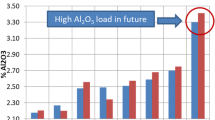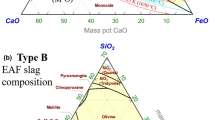Abstract
The proper control of slag composition is a dominant factor affecting yield of iron as well as dephosphorization efficiency in an electric arc furnace (EAF) operation. Moreover, thermophysical properties of slags such as viscosity are strongly affected by the changes in slag composition. Slag foaming , which is also a function of viscosity , is directly connected with the yield of iron and thus optimum slag chemistry are highly required in view of thermodynamics and physical properties. Therefore, we analyzed the slag composition in commercial melt shop (70 ton EAF) with the aim of higher yield of iron as well as higher dephosphorization during EAF process.
Access provided by CONRICYT-eBooks. Download conference paper PDF
Similar content being viewed by others
Keywords
Introduction
High yield of iron and dephosphorization efficiency are very important in electric arc furnace (EAF) operation. Even though various methods has been operated to increase iron recovery and dephosphorization efficiency , the suitable control of slag composition is one of dominant factors affecting them because thermodynamic driving force of FeO reduction and dephosphorization reaction as well as thermophysical properties of slags are strongly dependent on slag composition [1,2,3,4,5]. One of important technical issues in EAF operation is slag foaming which is strongly affected by slag viscosity . Foamy slag has several advantages during the operation such as shielding the electrical arc, reducing arc flares and corrosion of the refractory lining. However, excessive slag foaming causes instable operation such as sloping and entrapping metallic iron in foamy slag . Hence, the optimization of slag composition is very important to obtain high yield of iron and dephosphorization . Therefore, it is necessary to evaluate slag composition in commercial melt shop (70 ton EAF) in view of thermodynamics and phase equilibria .
Operational Slag Conditions
We analyzed the 66 heats’ slag compositions in a commercial 70 ton EAF melt shop. The composition of the representative slag is listed in Table 1. In addition, the window of the EAF slag is projected on the CaO–SiO2–FeO–15Al2O3–8MgO–10MnO (wt%) phase diagram at 1570 °C and pO2 = 10−10 atm as shown in Fig. 1.
The slag compositions are positioned near the magnesiowustite ([Mg,Fe]·O) saturation limit, which means that MgO content as well as basicity (CaO /SiO2 ) of slag are strictly controlled. Because basicity, which is a driving force for FeO reduction as well as dephosphorization , can be controlled by adding lime (and/or dolomite) during the operation, the effect of basicity on the thermodynamic behavior of FeO and P2O5 in molten slag will be discussed in following section.
Results and Discussion
Effect of Basicity on the Thermodynamic Behavior of FeO and P2O5 in EAF Slag
The effect of basicity on the content of FeO and P2O5 in molten slag is shown in Fig. 2. The content of FeO decreases, while P2O5 content increases as a function of basicity. Namely, FeO and P2O5 clearly behave as basic and acidic oxide, respectively, based on the following ionic reaction.
In order to understand the thermodynamic behavior of FeO and P2O5, the excess free energy of FeO and P2O5 (∆GEx) was plotted against basicity as shown in Fig. 3. Even though excess free energy of FeO exhibits some scatters, it generally increases with increasing basicity, whereas excess free energy of P2O5 linearly decreases with increasing basicity. However, excessively high basicity will cause the precipitation of magnesiowusite as well as dicalcium silicate (Ca2SiO4), resulting in an increase of apparent viscosity of slag .
Effect of Basicity and FeO Content on the Saturation Limit of MgO and Slag Foaming
Slag foaming is strongly affected by slag viscosity , which is dependent on MgO content as well as basicity. Specifically, precipitation of solid compounds increases apparently viscosity of slag . When the viscosity is too high due to suspended solid particles in slag phase, traveling of CO gas is hard to pass through the molten slag or induces excessive slag foaming which causes sloping phenomena. On the contrary, when the slag viscosity is too low, CO gas bubbles would rapidly pass through the molten slag , resulting in a reduction of foam life. Thus, it is necessary to examine the relationship between slag basicity and MgO content in view of slag foaming .
Figure 4 shows the effect of basicity on the saturation limit of MgO in the slag at 1500 and 1570 °C with measured MgO content in plant EAF slag . The MgO saturation limit, i.e., (%MgO)sat calculated by thermochemical software, FactSageTM continuously decreases as a function of basicity due to an increase in the activity coefficient of MgO in molten slag at fixed temperature . It is noteworthy that most of MgO content in plant EAF slag is not greater than theoretical (%MgO)sat limit.
Slag viscosity is also affected by FeO content. In order to estimate slag foamability, the effect of FeO content on the viscosity and foaming index (Σ) was estimated as shown in Fig. 5. Ito and Fruehan [6] Slag viscosity and foaming index decreases with increasing FeO content in the slag . Furthermore, foaming index is clearly affected by slag viscosity . Hence, it is also important to control FeO content in molten slag when basicity and MgO content are properly controlled.
Conclusions
In order to obtain high yield of iron and dephosphorization , thermodynamic driving force of FeO reduction and dephosphorization should be improved by increasing basicity. Furthermore, MgO solubility decreases with increasing basicity. Excessive basicity and MgO content causes solid precipitation which increases apparent viscosity , resulting in a decrease of yield of iron by entrapment of metallic iron droplets in the slag . Even though basicity and MgO content are well controlled, viscosity clearly decreases with increasing content of FeO, resulting in a decrease of slag foaming . Consequently, the optimization of slag composition by controlling basicity, MgO, and FeO content is required to have higher yield of iron and dephosphorization .
References
Nakamura S, Tsukihashi F, Sano N (1993) Phosphorus partition between CaOsatd–BaO–SiO2–FetO slags and liquid iron at 1873 K. ISIJ Int 33(1):53–58
Li G, Hamano T, Tsukihashi F (2005) The effect of Na2O and Al2O3 on dephosphorization of molten steel by high basicity MgO saturated CaO–FeOx–SiO2 Slag. ISIJ Int 45(1):12–18
Heo JH, Kim BS, Park JH (2013) Effect of CaO addition on iron recovery from copper smelting slags by solid carbon. Metall Mater Trans B 44B(6):1352–1363
Heo JH, Park JH (2017) Thermochemical analysis for the reduction behavior of FeO in EAF slag via aluminothermic smelting reduction (ASR) process: part Ι. Effect of aluminum on Fe and Mn recovery. Calphad 58:219–228
Heo JH, Park JH (2017) Thermochemical analysis for the reduction behavior of FeO in EAF slag via aluminothermic smelting reduction (ASR) process: part II. Effect of aluminum dross and lime fluxing on Fe and Mn recovery. Calphad 58:229–238
Ito K, Fruehan RJ (1989) Study on the foaming of CaO–SiO2–FeO slag: part II. Dimensional analysis and foaming in iron and steelmaking processes. Metall Mater Trans B 20B(4):515–521
Author information
Authors and Affiliations
Corresponding author
Editor information
Editors and Affiliations
Rights and permissions
Copyright information
© 2018 The Minerals, Metals & Materials Society
About this paper
Cite this paper
Heo, J.H., Park, J.H. (2018). Optimization of Slag Composition in View of Iron Recovery and Dephosphorization in EAF Process. In: Davis, B., et al. Extraction 2018. The Minerals, Metals & Materials Series. Springer, Cham. https://doi.org/10.1007/978-3-319-95022-8_89
Download citation
DOI: https://doi.org/10.1007/978-3-319-95022-8_89
Published:
Publisher Name: Springer, Cham
Print ISBN: 978-3-319-95021-1
Online ISBN: 978-3-319-95022-8
eBook Packages: Chemistry and Materials ScienceChemistry and Material Science (R0)









